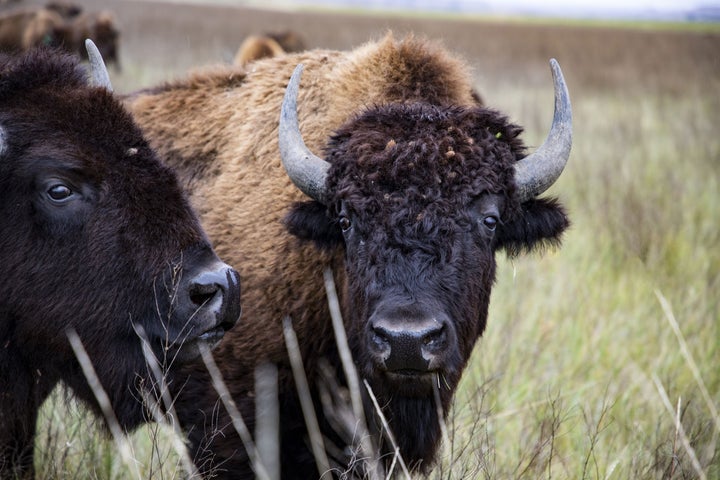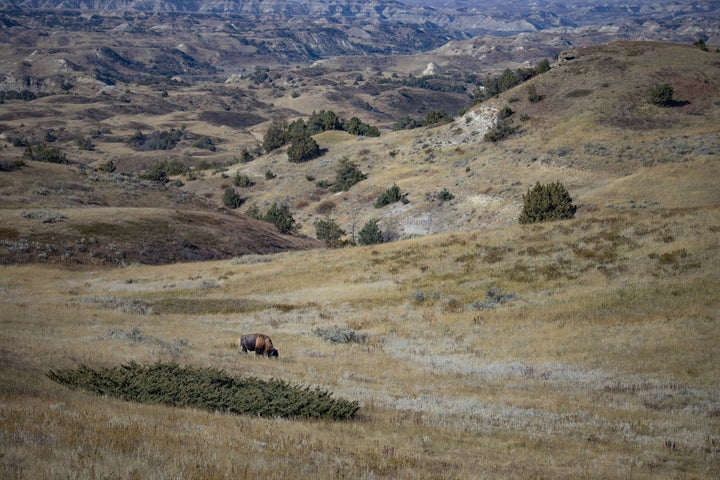When documentary filmmaker Ken Burns and longtime collaborator Dayton Duncan decided to make a documentary about the American buffalo, they had already done much of the work. America’s national mammal looms large in many of their other films — “Lewis and Clark,” “The National Parks,” “The West.” Dayton still had a copy of a fleshed-out proposal the pair had worked up in 1998.
“It’s the most magnificent mammal on our planet, and it intersected with our films on the West,” Burns said in an interview. “We’ve done lots of biographies on individuals. We just really thought, Wouldn’t it be great to do a biography of an animal?”
The 25-year delay ultimately worked in their favor. The two-part documentary, “The American Buffalo,” which premieres Monday on PBS, also comes amid a growing movement to return wild bison to the landscape after their near-total annihilation in the late 19th century — the legacy of a federal campaign to clear the animals off the land in order to conquer the plains tribes that depended on them and to make room for cattle and white settlers.

Somewhere between 30 million and 60 million wild buffalo roamed across North America at the time of European arrival. Today, only around 400,000 remain. Ranches raising buffalo as livestock, often with some level of cattle genetics, account for the overwhelming majority of them. Conservation herds of wild buffalo account for about 25,000 of the buffalo left on the landscape — less than a tenth of a percent of even the most conservative estimates of their former numbers.
For anyone trying to make sense of the current conservation debates and controversies over wild bison, “The American Buffalo” offers an excellent starting point. Based on 18 months of interviews with tribal leaders, conservationists and public intellectuals, the two-part documentary uses the history of the iconic animal to tell the story of the cultural clash that decimated wild herds and the indigenous peoples who built their lives around them.
“We all say we’re just like the buffalo — they almost exterminated us, too,” Gerard Baker, a member of the Mandan-Hidatsa tribe, says in the film. “The zoos kept the buffalo. The white people kept us on reservations. Same thing.”
It’s hard to imagine the sheer effort required to wipe out herds of buffalo that large and resilient. Even by 1871, when the buffalo killing campaigns had already decimated North America’s herds, a train heading into newly founded Dodge City, Kansas, had to stop and wait for two hours to let a three-mile-long bison herd pass, the documentary notes.
Part one of the documentary begins by detailing how buffalo-hunting tribes wove all aspects of the animal into their daily lives, then begins the story of the animal’s century-long slide toward near-extinction.
The second part traces the history of the conservation movement, led by figures including naturalist George Bird Grinnell, ranchers Michel Pablo and Charles Allard of the Flathead Reservation, and former President Theodore Roosevelt that saved the species in the 19th century.
Though the second part of the story is more uplifting than the first, the story of the American buffalo remains tragic even as the film nears the present day.

The conservation push that birthed what is today known as the North American Model of Wildlife Conservation did an outstanding job of restoring pillaged populations of elk, deer, turkey and other wildlife, along with fostering a culture of support for public land ownership and habitat preservation. It is widely viewed as the leading model for wildlife conservation globally.
Although its early adherents played a key role in keeping a smattering of bison alive, wild bison remain one of the North American Model’s greatest failures — partly because the federal government systematically privatized tribal reservation land, with laws like the Dawes Act of 1887, for the benefit of white homesteaders and ranchers. Once a keystone species of the plains, today the bison is ecologically extinct.
The documentary stops roughly in 1996, with the founding of the Inter-Tribal Bison Cooperative, a tribal-led effort to build conservation herds on reservations, restoring indigenous people’s cultural, spiritual and dietary links to bison. The organization has grown to more than 80 members and is now called the Inter-Tribal Buffalo Council.
The filmmakers refer to modern developments like these, which fall outside the scope of the documentary, as the story’s “third act.”
“It is a heartbreaking story of a collision of two different views of how human beings should interact with the natural world,” writer Dayton Duncan says in the film. “And there’s a tragedy at the very heart of that story. At the same time, as you follow a little farther down that trail, it can offer us hope.”
That metaphorical third act is playing out on several fronts today.
Conservation herds on tribal lands are making buffalo a common sight and returning bison meat to the table after a century-long absence. The U.S. Fish and Wildlife Service is reviewing whether Yellowstone bison merit protection under the Endangered Species Act. Private conservation herds like the one at the American Prairie project, a nature reserve, are growing in scale.
And in a bold move, the Blackfeet Nation set four dozen wild buffalo free on tribal land abutting Glacier National Park this summer, marking the first large-scale release of a wild herd in generations that is all but sure to migrate onto federal public land.
But lingering tensions over the future role that buffalo will play on the landscape remain. With the exception of the Blackfeet herd and a wild herd in the Henry Mountains of Utah, virtually all wild buffalo today are fenced off to prevent them from mixing with cattle, mostly out of fear that bison will spread a costly disease called brucellosis, which causes spontaneous abortion and low birthweight.
“One of the concerns as we move forward into the future is the creation of large ecosystems for bison to live on and whether or not bison will be free-roaming animals,” historian Roselyn LaPier, who appears in the film, said at a press conference. “Right now they are not.”
Though the documentary doesn’t touch on these issues directly, Burns said he hopes spreading the story can help people understand them in the future.
“A good story can reach everybody,” Burns added. “And that’s what we tried to do.”

